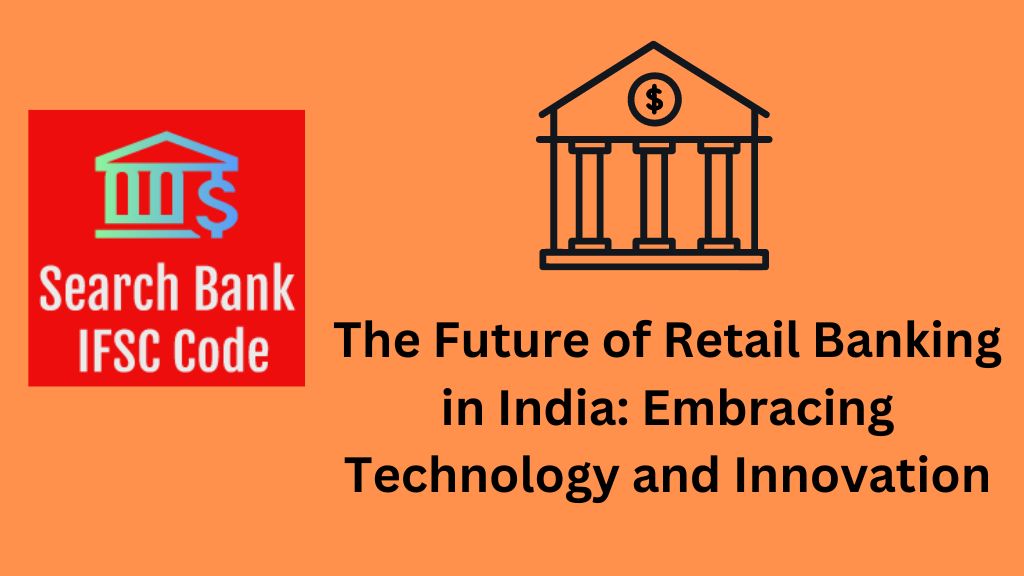The Future of Retail Banking in India: Embracing Technology and Innovation
Created at: 2023-07-28
Introduction
Retail banking in India has come a long way since its inception. From traditional brick-and-mortar branches to embracing the digital age, the industry has witnessed a significant transformation. With the rapid advancement of technology and changing consumer behavior, the future of retail banking in India holds exciting prospects. This article explores the key trends and innovations that are shaping the future of retail banking in the country.

Digital Banking and Mobile Apps
One of the most significant developments in the retail banking sector is the rise of digital banking and mobile apps. As smartphones become more accessible to the masses, customers are increasingly turning to mobile apps for their banking needs. With features like balance inquiries, fund transfers, bill payments, and mobile wallets, mobile banking apps provide convenience and ease of use. Banks are investing heavily in developing user-friendly and secure mobile apps to cater to the evolving needs of tech-savvy customers.
Personalization and Customer Experience
In the future, retail banking will be all about personalization and enhancing customer experience. Banks are leveraging artificial intelligence and big data analytics to gain insights into customer behavior and preferences. This data-driven approach enables banks to offer tailor-made solutions and personalized recommendations to customers. By understanding their customers better, banks can deliver more targeted and relevant products and services, thereby improving overall customer satisfaction.
AI-Powered Chatbots and Virtual Assistants
AI-powered chatbots and virtual assistants are becoming integral parts of the retail banking experience. These intelligent bots can handle routine customer queries, provide assistance, and even execute transactions. By automating customer service, banks can reduce response times, increase efficiency, and enhance customer support. As AI technology continues to advance, these chatbots are expected to become more sophisticated, offering a seamless and human-like interaction with customers.
Contactless Payments and NFC Technology
Contactless payments are rapidly gaining popularity in India. Near Field Communication (NFC) technology enables customers to make transactions by simply tapping their cards or mobile phones on a point-of-sale (POS) terminal. The convenience and speed of contactless payments have made them a preferred choice for customers. Additionally, the introduction of Unified Payments Interface (UPI) has revolutionized person-to-person (P2P) and person-to-merchant (P2M) payments, further driving the adoption of digital transactions.
Biometric Authentication and Security
With the increasing adoption of digital banking, ensuring robust security is paramount. Biometric authentication, such as fingerprint and facial recognition, is becoming a standard security feature in mobile banking apps. These biometric authentication methods provide an added layer of security, reducing the risk of unauthorized access to customer accounts and sensitive data.
Open Banking and Collaboration
Open banking is an emerging trend that fosters collaboration between traditional banks and fintech companies. Through Application Programming Interfaces (APIs), banks can securely share customer data with third-party fintech providers. This collaboration allows fintech companies to develop innovative solutions that complement traditional banking services. Open banking not only promotes innovation but also creates a more competitive and diverse banking ecosystem.
Financial Inclusion and Rural Penetration
Despite significant progress, there remains a considerable gap in financial inclusion in India, especially in rural areas. The future of retail banking aims to address this gap by leveraging technology to extend banking services to the unbanked and underbanked populations. Mobile banking, along with digital wallets and microfinance platforms, has the potential to drive financial inclusion and empower millions of individuals with access to formal banking services.
Conclusion
The future of retail banking in India holds great promise as it embraces technology and innovation to cater to the evolving needs of customers and financial institutions alike. The transformation of the retail banking sector is set to revolutionize the entire banking experience, making it more convenient, secure, and customer-centric.
The widespread adoption of digital banking and mobile apps is reshaping the way customers interact with their banks. With seamless access to banking services at their fingertips, customers can now manage their finances with unprecedented ease and convenience. The proliferation of AI-powered chatbots and virtual assistants further enhances customer service, providing instant support and resolving queries round-the-clock.
Personalization is becoming a key focus for banks as they leverage data analytics to gain deeper insights into customer behavior. By understanding individual preferences and financial goals, banks can offer tailored solutions and recommendations, empowering customers to make well-informed financial decisions.
Contactless payments and NFC technology have ushered in a new era of swift and secure transactions. With the adoption of UPI, person-to-person and person-to-merchant payments have become seamless and hassle-free. This not only simplifies the payment process for customers but also contributes to the government's vision of a cashless economy.
Security remains a top priority for the retail banking industry, and biometric authentication has emerged as a reliable safeguard. With fingerprint and facial recognition technologies, customers can have peace of mind knowing their accounts and sensitive information are well-protected.
The rise of open banking and collaboration between traditional banks and fintech companies is driving innovation and expanding the range of services available to customers. Through APIs, banks can partner with fintech providers to offer cutting-edge solutions that cater to specific financial needs.
Moreover, retail banking is playing a crucial role in bridging the financial inclusion gap. By leveraging technology, banks are reaching out to underserved communities and providing them with access to basic banking services. This empowerment is not only improving financial literacy but also contributing to the socio-economic development of the nation.
As the retail banking sector continues to evolve, financial institutions must adapt and stay ahead of the curve. Embracing technological advancements and customer-centric strategies will be the key to maintaining a competitive edge in the dynamic market.
In conclusion, the future of retail banking in India is indeed exciting, offering transformative opportunities that will reshape the way customers interact with banks and the overall financial landscape. By embracing technology and innovation, retail banking is set to become more accessible, inclusive, and efficient, ensuring a brighter and more prosperous future for all stakeholders involved.
At SearchBankIFSCCode, we strive to provide valuable insights into various aspects of banking, finance, and investment. Our website offers a user-friendly platform where you can explore detailed information about banks, their IFSC codes, MICR codes, and other essential banking details. Whether you are looking for specific bank branches, IFSC codes for fund transfers, or information about the Indian financial system, our comprehensive database is designed to cater to your needs. We are committed to empowering Indian investors with knowledge and resources to make informed financial decisions. Visit SearchBankIFSCCode to stay updated with the latest trends in banking and finance, and embark on your journey towards financial prosperity. To learn more about banking in India, check out Citi Bank's comprehensive offerings.





